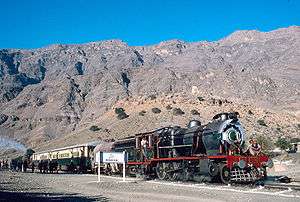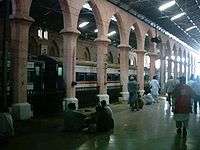Pakistan Railways
Native name | پاکستان ریلویز |
|---|---|
| State-owned enterprise | |
| Industry | |
| Predecessor | North Western State Railway |
| Founded | 13 May 1861[1] |
| Headquarters | Lahore, Pakistan |
Area served | Pakistan |
Key people |
|
| Services | |
| Revenue |
|
|
| |
| Owner | Government of Pakistan |
Number of employees | 78,031[4] (2015) |
| Parent | Ministry of Railways |
| Divisions | 6 |
| Website |
| Reporting mark | PR |
|---|---|
| Locale | Pakistan |
| Track gauge |
1,676 mm (5 ft 6 in) 1,000 mm (3 ft 3 3⁄8 in) 762 mm (2 ft 6 in) |
| Length |
7,791 kilometres (4,841 mi) (route)[5] 11,881 kilometres (7,383 mi) (track) |
Pakistan Railways (reporting mark PR) (Urdu: پاکستان ریلویز), formerly also known as the Pakistan Western Railway between 1947 to 1974, is the a national state-owned railway company of Pakistan. Founded in 1861 and headquartered in Lahore, it owns approximately 4,800 miles (7,791 km) of track across Pakistan, stretching from Torkham to Karachi. Pakistan Railways is currently going through a PKR 886.68 billion ($8.5 billion) upgrade as part of the China–Pakistan Economic Corridor. The first phase of the project will be completed in December 2017, while the second phase will be complete by the year 2021.[6]
History

The history of rail transport in Pakistan covers the period beginning in 1855 during the British Raj, when several railway companies began laying track and operating in what is today Pakistan, and ending during the present-day nationalised company under the name of Pakistan Railways. The railway system in Pakistan was originally built as a patchwork of local rail links operated by small private railway companies. These included the Scinde Railway, Punjab Railway, Delhi Railway and Indus Steam Flotilla companies. In 1870, these 4 companies were amalgamated into the Scinde, Punjab & Delhi Railway company. Shortly thereafter, several other railways lines were built including the Indus Valley State Railway, Punjab Northern State Railway, Sind–Sagar Railway, Sind–Pishin State Railway, Trans–Baluchistan Railway and Kandahar State Railway. These 6 companies along with the Scinde, Punjab & Delhi Railway company merged together to form the North Western State Railway in 1880.
In 1947, when Pakistan achieved its independence from Britain, the North Western State Railway was renamed to Pakistan Western Railway while in East Bengal, the portions of the Assam Bengal Railway was renamed to Pakistan Eastern Railway. During the early years after independence, the railway system underwent reorganisation, some of which proved controversial. Pakistan adopted 8,122 kilometres (5,047 mi) of the North Western State Railway. Of this 6,880 kilometres (4,280 mi) was 1,676 mm (5 ft 6 in), 506 kilometres (314 mi) was 1,000 mm (3 ft 3 3⁄8 in), and 736 kilometres (457 mi) was 762 mm (2 ft 6 in) narrow gauge.[7][8] From 1948, usage of railways increased and the network became profitable. From 1950 to 1955, the Mashriq-Maghreb Express operated from Koh-e-Taftan in West Pakistan to Chittagong in East Pakistan, using Indian railway track and rolling stock for a 1986 km (1245 miles) journey between Attari and Benapole. In 1954, the railway lines were extended to Mardan and Charsada, and in 1956 the Jacobabad-Kashmore 2 ft 6 in (762 mm) gauge line was converted to 1,676 mm (5 ft 6 in). In 1974, Pakistan Western Railways was renamed to Pakistan Railways. The Kot Adu-Kashmore section was constructed between 1969 and 1973 providing an alternative route from Karachi to northern Pakistan. In February 2006, the Mirpur Khas-Khokhrapar 126 km metre gauge railway line was converted to Broad gauge. On 8 January 2016 Lodhran-Raiwind double rail track was completed. Declining passenger numbers and financial losses in the late 1980s to early 1990s prompted the closure of many branch lines and small stations. The 1990s saw severe cuts in rail subsidies and mismanagement within the company. Due to falling passenger numbers, rail subsidies from the government are necessary to keep the railways financially viable.
Structure
Pakistan Railways is a state-owned enterprise under the Ministry of Railways. The Ministry of Railways Secretary is the official chairman of the Pakistan Railway Board. Pakistan Railways comprises three functional units:[9]
Manufacturing unit
Pakistan Locomotive Factory, Risalpur
The Pakistan Locomotive Factory was established in Risalpur in 1993, at a total cost of ₨228.4 million (US$2.2 million), equipped with state-of-the-art machinery. The purpose of the factory was to manufacture indigenous diesel electric and electric locomotives, by maximizing local manufacturing of major assemblies and vital spare parts to meet with the demand of Pakistan Railways.
Carriage Factory, Islamabad
The Carriage Factory Islamabad was built for manufacturing new carriages for Pakistan Railways in 1970.
Concrete Sleeper Factories
Pakistan Railways owns five concrete sleeper factories in Sukkur, Khanewal, Kohat, Shahinabad and Kotri. The first factory was established in Sukkur in 1967, while the remaining four factories were opened between 1979 to 1981.
Operating unit
The operating unit is further divided into 3 main departments. The Infrastructure Department oversees civil engineering, signaling, telecommunications, design and the directorate of property. The Mechanical Engineering Department oversees mechanical engineering, purchasing, stores and electrical engineering. The Traffic Department oversees passenger facilities, operations, marketing and the directorate of information technology. Several smaller departments also fall under the operating unit, including the Personnel Department, Railways Police Department, Planning Department, Directorate of Legal Affairs, Directorate of Public Relations and the Pakistan Railways Academy.
Welfare & special initiative unit
The welfare and special initiate unit consists of the medical department, directorate of education and railway sports.
Operations
Divisions
Pakistan Railway comprises of eight territorial operating divisions:
Track and gauge
Pakistan Railways has a mixture of gauges. At the moment, Pakistan Railways is undergoing a project to convert all tracks to 1,676 mm (5 ft 6 in). The project will be complete by 2025.
- 1,676 mm (5 ft 6 in) or broad gauge track
- 1,000 mm (3 ft 3 3⁄8 in) or metre gauge track
- 762 mm (2 ft 6 in) or narrow gauge track
Axle load limit
Pakistan Railways' broad gauge track axle load limit is 22.86 tonnes with exceptions at the Rohri-Chaman Railway Line (limit 17.78 tonnes) and Quetta-Taftan Railway Line (limit 17.27 tonnes)
Speed
The maximum speed of trains on most railway lines is 120 km/h, however, certain upgraded sections of the Karachi-Peshawar Railway Line line allow speeds up to 150 km/h. Work is in progress to upgrade all Main Lines in Pakistan to speeds above 150 km/h.
Passenger services
Passenger traffic comprises 50% of the total revenue annually. During 1999-2000, this amounted to Rs. 4.8 billion. Pakistan Railways carries 65 million passengers annually and daily operates 228 mail, express and passenger trains. Daily the railway carries an average of 178,000 people. Pakistan Railways also operates special trains during occasions such as Eid ul Fitr, Eid ul Azha, Independence Day and Raiwind Ijtema. The railway authorities have set up a website[10] with all information regarding availability, departure and arrival of all trains, which is updated time to time as required. Current system of Pakistan Railways is much more simple and straightforward as the fares and routes calculated as per requirement can be seen directly from website. Also that the reservations of passengers are confirmed by an SMS sent to his mobile containing the details of reservation. This can be stated as the milestone which is achieved in the sole history of Pakistan Railways.
Freight services
The Freight Business Unit, with 12,000 personnel, operates over 200 freight stations on the railway network. The unit serves the Ports of Karachi and Bin Qasim as well as all four provinces of the country and generates revenue from the movement of agricultural, industrial and imported products such as petroleum oil & lubricants, wheat, coal, fertilizer, rock phosphate, cement and sugar. About 39% of the revenue is generated from the transportation of POL products, 19% from imported wheat, fertilizer and rock phosphate. The remaining 42% is earned from domestic traffic. The Freight Business Unit is headed by an additional General Manager.
| Wikinews has related news: Pakistan to Turkey container train service launched |
As on 14 August 2009 by Prime Minister Yousuf Raza Gilani between Islamabad and Istanbul via Tehran. The first train carried 20 containers with a capacity of around 750 t (738 long tons; 827 short tons) [11] and will travel 6,500 km (4,000 mi) from Islamabad, through Tehran, Iran and on to Istanbul in two weeks' time.[12] According to the Minister for Railways Ghulam Ahmad Bilour, after the trial of the container train service, a passenger train will be launched.[13] There are also hopes the route will provide a link to Europe and Central Asia, and carry passengers.[14][15]
Fleet
Locomotives
| Class | Image | Type | Top speed | Number | Remarks | Built | |
|---|---|---|---|---|---|---|---|
| mph | km/h | ||||||
Classes
Pakistan Railways has several classes of travel. Depending on the route, certain trains may only have a single class. The fares for all classes are different with unreserved seating class being the cheapest. The following table lists the classes in operation.
| Class | Description |
|---|---|
| AC Sleeper | This is the most expensive class. The coach has an attendant to help the passengers. Bedding is included with the fare and the carriage is air conditioned. The sleeper berths are extremely wide and spacious. The coaches are carpeted, have sleeping accommodation and have privacy features like personal coupes. |
| 1st Class Sleeper | |
| Parlour | |
| Economy | |
| 2nd Class |
Network
Pakistan Railways network are divided into main lines and branch lines. The Karachi-Peshawar line serves as the main North-South line while the Rohri-Chaman line serves as the main East-West line.
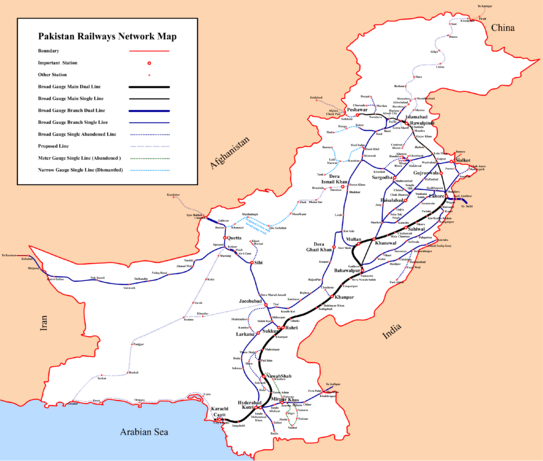


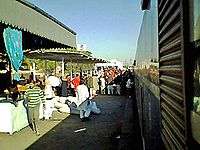



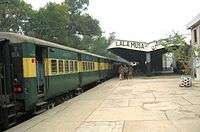

Main lines
- Main Line 1 (ML-1) Karachi–Peshawar Railway Line
- Main Line 2 (ML-2) Kotri–Attock Railway Line
- Main Line 3 (ML-3) Rohri–Chaman Railway Line
- Main Line 4 (ML-4) Quetta–Taftan Railway Line
- Main Line 5 (ML-5) Taxila–Khunjerab Railway Line
Branch lines
- Hyderabad–Badin Branch Line
- Hyderabad–Khokhrapar Branch Line
- Bahawalnagar–Fort Abbas Branch Line
- Samasata–Amruka Branch Line
- Sher Shah–Kot Addu Branch Line
- Golra Sharif–Thal Branch Line
- Lodhran–Khanewal Branch Line
- Lodhran–Raiwind Branch Line
- Khanewal–Wazirabad Branch Line
- Wazirabad–Narowal Branch Line
- Shahdara Bagh–Sangla Hill Branch Line
- Shahdara Bagh–Chak Amru Branch Line
- Shorkot–Sheikhupura Branch Line
- Shorkot–Lalamusa Branch Line
- Sangla Hill–Kundian Branch Line
- Lahore–Wagah Branch Line
International links
![]() Iran -
A 1,676 mm (5 ft 6 in) Quetta-Taftan Railway Line, and a 1,435 mm (4 ft 8 1⁄2 in) line is finished from Zahedan to Kerman in central Iran, linking with the rest of the Iranian rail network. On May 18, 2007, a MOU for rail cooperation was signed by Pakistan and Iran under which the line will be completed by December 2008. Now that the rail systems are linked up at Zahedan, there is a break-of-gauge between the Islamic Republic of Iran Railways 1,435 mm (4 ft 8 1⁄2 in) tracks and Pakistan Railway's gauge tracks.
Iran -
A 1,676 mm (5 ft 6 in) Quetta-Taftan Railway Line, and a 1,435 mm (4 ft 8 1⁄2 in) line is finished from Zahedan to Kerman in central Iran, linking with the rest of the Iranian rail network. On May 18, 2007, a MOU for rail cooperation was signed by Pakistan and Iran under which the line will be completed by December 2008. Now that the rail systems are linked up at Zahedan, there is a break-of-gauge between the Islamic Republic of Iran Railways 1,435 mm (4 ft 8 1⁄2 in) tracks and Pakistan Railway's gauge tracks.
![]() Afghanistan -
There is no rail link to Afghanistan, since no railway network is present in that country. Pakistan Railway has proposed to help build an Afghan rail network in three phases. The first phase would stretch from the Chaman to Spin Boldak, as an extension of the Rohri-Chaman Railway Line. The second phase would extend the line from Spin Boldak to Kandahar and the third phase would extend from Kandahar to Herat and on wards to Khushka, Turkmenistan. The final phase would link the 1,676 mm (5 ft 6 in) with the Central Asian 1,520 mm (4 ft 11 27⁄32 in). It is not clear where the break-of-gauge station will be.[16] Another proposal is to extend the Karachi-Peshawar Railway Line to Kabul via Jalalabad.
Afghanistan -
There is no rail link to Afghanistan, since no railway network is present in that country. Pakistan Railway has proposed to help build an Afghan rail network in three phases. The first phase would stretch from the Chaman to Spin Boldak, as an extension of the Rohri-Chaman Railway Line. The second phase would extend the line from Spin Boldak to Kandahar and the third phase would extend from Kandahar to Herat and on wards to Khushka, Turkmenistan. The final phase would link the 1,676 mm (5 ft 6 in) with the Central Asian 1,520 mm (4 ft 11 27⁄32 in). It is not clear where the break-of-gauge station will be.[16] Another proposal is to extend the Karachi-Peshawar Railway Line to Kabul via Jalalabad.
![]() China -
There is no rail link with China at present. On 28 February 2007, contracts were awarded for several feasibility studies on the Taxila–Khunjerab Railway Line line from extending from Havelian via the Khunjerab Pass, to the Chinese railhead at Kashgar, a distance of about 750 km.[17]
China -
There is no rail link with China at present. On 28 February 2007, contracts were awarded for several feasibility studies on the Taxila–Khunjerab Railway Line line from extending from Havelian via the Khunjerab Pass, to the Chinese railhead at Kashgar, a distance of about 750 km.[17]
![]() Turkey -
The completion of the Pakistan-Iran link has made it possible, in principle, to run trains between Pakistan and Turkey via Iran. A container train trial service was launched by Prime Minister Yousuf Raza Gilani between Islamabad and Istanbul on 14 August 2009. The first train carried 20 containers with a capacity of around 750 t (738 long tons; 827 short tons) [11] and will travel 6,500 km (4,000 mi) from Islamabad, through Tehran, Iran and on wards to Istanbul.[12][18] An Istanbul-Tehran-Islamabad passenger rail service has also been proposed as well.[19] In 2009, the Minister for Railways Ghulam Ahmad Bilour expressed hope that after the trial of the container train service, a passenger train will be launched.[13] There are also hopes the route will provide a link to Europe and Central Asia in the future, and carry passengers.[14]
Turkey -
The completion of the Pakistan-Iran link has made it possible, in principle, to run trains between Pakistan and Turkey via Iran. A container train trial service was launched by Prime Minister Yousuf Raza Gilani between Islamabad and Istanbul on 14 August 2009. The first train carried 20 containers with a capacity of around 750 t (738 long tons; 827 short tons) [11] and will travel 6,500 km (4,000 mi) from Islamabad, through Tehran, Iran and on wards to Istanbul.[12][18] An Istanbul-Tehran-Islamabad passenger rail service has also been proposed as well.[19] In 2009, the Minister for Railways Ghulam Ahmad Bilour expressed hope that after the trial of the container train service, a passenger train will be launched.[13] There are also hopes the route will provide a link to Europe and Central Asia in the future, and carry passengers.[14]
![]() Turkmenistan -
via Afghanistan (proposed) - avoiding 1,435 mm (4 ft 8 1⁄2 in) (or narrow gauge) intervening.[20]
Turkmenistan -
via Afghanistan (proposed) - avoiding 1,435 mm (4 ft 8 1⁄2 in) (or narrow gauge) intervening.[20]
![]() India -
There are 2 rail links to India. The Thar Express (Bhagat Ki Kothi (near Jodhpur, Rajasthan) to Karachi) and Samjhauta Express (Delhi to Lahore).
India -
There are 2 rail links to India. The Thar Express (Bhagat Ki Kothi (near Jodhpur, Rajasthan) to Karachi) and Samjhauta Express (Delhi to Lahore).
Expansion
Restructuring
In March 2010, the Pakistani government announced plans to split Pakistan Railways into four privatised businesses; focused on passenger operations, freight, infrastructure, and manufacturing.[21] In February 2010, "unbundling" was proposed, with activities being outsourced, privatised, or operated separately. However, complete privatisation has been ruled out.[22]
New lines
In 2006 it was announced that a railway line between Gwadar and Quetta will be built and the Bostan-Zhob 2 ft 6 in (762 mm) narrow gauge railway line will be converted into 1,676 mm (5 ft 6 in) in 2007 at a cost of US$1.25 billion. Plans to increase train speeds, install more lengths of double track and to build Gwadar to Chabahar line to standard gauge are being made.
Breaks of gauge
There are proposals for break-of-gauge stations:
- Inside Pakistan
- 1,676 mm (5 ft 6 in)/1,435 mm (4 ft 8 1⁄2 in) at Gwadar Port
- Outside Pakistan
- 1,676 mm (5 ft 6 in)/1,520 mm (4 ft 11 27⁄32 in) in Russia and the Central Asian Republics, and at Mazar-i-Sharif, Afghanistan
- 1,676 mm (5 ft 6 in)/1,435 mm (4 ft 8 1⁄2 in) at Kashgar, China
Track doubling
The Lodhran - Multan - Khanewal line (121 km) was dual-tracked; work began in 2003 and completed on 16-03-2007.
The Khanewal - Raiwind line (246 km) is being doubled, at a cost of Rs.8.326 billion. The project commenced in July 2005. The section from Khanewal to Sahiwal (119 km) has been opened as a double line section in 2010. The work of dualization of the railway track from Karachi to Shahdara Bagh has been completed.
The following lines are planned to be doubled:
- Shahdara Bagh - Lalamusa
- Total length 126 km
- Total cost Rs.14136 million
- Completion period 3 years from the date of commencement
- Shahdara Bagh - Faisalabad
- Total length 135 km
- Total cost Rs.10486 million
- Completion period 3 years from the date of commencement
- Lalamusa - Chaklala
- Total length 152 km
- Total cost Rs.23770 million
- Completion period 4 years from the date of commencement
- Golra Sharif - Peshawar Cantt
- Total length 160 km
- Total cost Rs.19560 million
- Completion period 4 years from the date of commencement
Public-private partnership
Pakistan Railways has faced a severe financial and management crisis under the ministership of Mr. Bilor. In those circumstances the department has met with private operators. In this pursuit Pakistan Railway has started several trains on a public-private partnership. Pakistan Business Express Train commenced its maiden Journey on 3 February. 2012 and Shalimar Express resumed its operation on 25 February 2012.[23]
High-speed rail
In 2008, Pakistan Railways announced a plan for the construction of a $1 billion high-speed railway line between Punjab and Sindh[24]
International lines
Direct rail connections with China were proposed by Pervez Musharraf in 2006.[25]
A container train service from Pakistan to Turkey was launched 14 August 2009 on a trial basis.[26] This service did not materialise until 2015.
| Wikinews has related news: Pakistan to Turkey container train service launched |
The Samjhauta Express and the Thar Express, jointly operated with Indian Railways, connect Pakistan Railways to India.
China-Pakistan Economic Corridor
China is involved in the development of Pakistan Railways and for the past five years it has been increasing its stake in the country's communication sector. The freight-passenger earnings comprise 50% of the railway's total revenue. Pakistan Railways carries 65 million passengers annually and operates 228 mail, express and passenger trains daily. It introduced new mail and express trains between major terminals from 2003 to 2005. Pakistan Railways has entered agreements with Chinese railway companies for its development. In 2001, Pakistan Railways signed a $91.89 million contract with China National Machinery Import and Export Corp for the manufacture of 175 new high-speed passenger coaches. The project was funded by Exim Bank China on a supplier credit basis. Forty completely built passenger coaches have been received and 105 will be assembled in Pakistan Railways' carriage factory by next December. These coaches are being used on Pakistan Railways' mail and express trains from Rawalpindi-Lahore-Karachi, Lahore-Faisalabad and Rawalpindi-Quetta. The manufacturing kits for the remaining 30 coaches have also been received and manufacturing is in progress with 12 already assembled. The technology transfer for these coaches has been obtained from China's Chang Chun Car Co. Under an agreement signed with China in 2003, Pakistan Railways purchased 69 locomotives, of which 15 were delivered as completely built units and are in use by Pakistan Railways. The remaining 54 are to be built at Pakistan Railways' locomotive factory. The Chinese locomotives are 37% cheaper than the European locomotives. Some in Pakistan have been criticizing the faulty locomotives purchased by Pakistan Railways from Dong Fang Electric Corp of China. Pakistan Railways have decided to purchase 45 more 2,000-3,000-horsepower locomotives from the same company. The company is willing to redesign the already-delivered 30 locomotives of the original order, such that the underframe is strengthened and the weight reduced to less than 140 tons. A Chinese company, Beijing Research and Design Institute, is committed to providing 300 rail cars to Pakistan Railways.
Under another agreement signed in 2004 with China National Machinery and Equipment Group, the Chinese company is to undertake the construction of Corridor 1 of a light-rail mass-transit system for Karachi that is intended to serve 4 million commuters. The project will cost about $568 million and take four and a half years to complete. The contract has been awarded on a build-operate-transfer basis and comprises five corridors. Pakistan signed a series of agreements with China during the past three years to enhance the capability of its railway system. Under an agreement signed between Pakistan and China Railway, a Chinese company will provide 1,300 freight cars to Pakistan Railways, of which 420 will be manufactured in China and the remaining 880 will be produced at the Moghalpura railway workshops in Lahore. Under another project, 450 passenger coaches will be rehabilitated at an estimated cost of Rs2.14 billion. The project also includes the conversion of 40 coaches into air-conditioned cars and the conversion of 10 power vans. Furthermore, there is a provision of 100 new high-speed bogies, 30 of which will be imported from China, while 70 will be manufactured locally on a transfer-of-technology basis. Under a separate agreement, 175 new passenger coaches are being purchased from China.
As part of a $100 million agreement signed between Pakistan and China in November 2001, China is to export 69 locomotive engines to Pakistan to modernize Pakistan's railway fleet. The first eight engines have been completed and are ready for shipment to Karachi. The new engines consume less fuel than older models and are cheaper to maintain. The main feature of this deal is that the first 15 engines will be manufactured in China and the remainder will be assembled in Pakistan, with spare parts and technology provided by China. Similarly, for a Rs7.2 billion railway project in Sindh province involving laying 78,000 tons of rails, China delivered 64,000 tons to Pakistan Railways.
Karakoram Railway
Pakistan awarded a Rs72 million (US$1.2 million) contract to an international consortium to carry out a feasibility study for establishing a rail link with China to boost trade relations between the two countries. The study will cover a 750-kilometre section between Havellian and the 4,730-metre-high Khunjerab Pass over Mansehra district and the Karakoram Highway. Havellian is already linked with the rest of the rail network in Pakistan; the Chinese will lay some 350 km of track within their own territory from Kashgar terminus up to the Khunjerab Pass, linking Pakistan with China's rail network, largely following the route of the Karakoram Highway. By expanding its stake in Pakistan's rail sector, China can exploit the country's advantageous geographical position at the confluence of south, central and west Asia. In the first week of February 2007, Pakistan Railways and China's Dong Fang Electric Supply Corp signed an agreement for establishing a rail link between Havellian and Khunjerab. Ingenieurgemeinschaft Lasser-Feizlmayr (ILF), a consortium of consultant engineers from Austria, Germany and Pakistan, is to submit its report to the Ministry of Railways in nine months. It is most likely that the distance between Havellian and Khunjerab will involve the construction of tunnels. The ILF services encompass both the construction of new high-speed railway lines and the modernisation of existing lines for standard gauge and narrow gauge railways in addition to tunnels.[27] The pre-feasibility study was completed in July 2011.[28]
Gwadar link
As a part of its development plan for its transport and communications network, Pakistan Railways has completed a feasibility study of the Chaman-Kandahar section for laying railway tracks between Pakistan and Turkmenistan through Afghanistan. The feasibility study for cost, engineering and design for the construction of a rail link from Gwadar to the existing rail network in Mastung district in Balochistan has also been finalised. The new link to Gwadar port will open up underdeveloped areas of Balochistan for development. The main aim of the venture is to connect the Central Asian republics with Pakistan Railways' network through Afghanistan.
China is going to be the beneficiary of Gwadar's most accessible international trade routes to the Central Asian republics and China's Xinjiang border region. By extending its East-West Railway from the Chinese border city of Kashi to Peshawar in Pakistan's northwest, Peking can receive cargo to and from Gwadar along the shortest route, from Karachi to Peshawar. The rail network could also be used to supply oil from the Persian Gulf to Xinjiang. Pakistan's internal rail network can also provide China with rail access to Persia.
Incidents
- Sukkur rail disaster
- The Sukkur rail disaster occurred on 4 January 1990 in the village of Sangi near Sukkur in the Sindh Province of Pakistan. 307 people were killed making it Pakistan's worst rail disaster.[29] The train (Bahauddin Zakaria Express) concerned was on a 500-mile (800 km) overnight run from Multan to Karachi and was carrying many more passengers in its 16 carriages than its 1408-seat capacity. It was supposed to pass through the village of Sangi but incorrectly set points sent it into a siding where it collided with an empty 67-car freight train at a speed of at least 35 mph.
- Ghotki train crash
- In its worst accident in recent years, three passenger trains collided on 13 July 2005, derailing 13 carriages and leaving at least 120 dead. The Karachi Express ran into the back of the Quetta Express while it was stopped at a station near Ghotki, and the Tezgam travelling in the opposite direction hit several of the derailed carriages. According to officials, the conductor of the Karachi Express misread a signal.[30]
| Wikinews has related news: Train crash in southern Pakistan kills more than a hundred |
- Super Parcel Express
- On 21 August 2005, the upcountry Super Parcels Express derailed while crossing the Malir Bridge near Landhi in the Karachi Division. Eight bogies were substantially damaged when an axle broke due to overloading. Rail traffic was suspended for 24 hours. All down trains were terminated at Landhi and the rakes and the locos turned around from Landhi.
- Mehrabpur train derailment
- On 19 December 2007, the Karachi Express, an express service from Karachi to Lahore, derailed near the town of Mehrabpur in the Sindh province of Pakistan. At around 2:25 a.m. local time, fourteen of the train's sixteen carriages left the tracks, some being mangled by the crash, others simply sliding down an embankment into the water. Sabotage and terrorism were ruled out as the reason for the crash, with officials believing a faulty track was the cause of the derailment.[31]
See also
References
- ↑ http://www.pakrail.com/ybook2.pdf
- ↑ http://www.pakrail.com/ybbt.pdf
- ↑ http://tribune.com.pk/story/1160520/downfall-pakistan-railways-suffers-another-loss-making-year/
- ↑ http://www.pakrail.com/ybbt.pdf
- ↑ http://www.pakrail.com/ybbt.pdf
- ↑ "$8.2b railtrack upgrade project wins go-ahead - The Express Tribune". The Express Tribune. 2016-06-08. Retrieved 2016-06-23.
- ↑ Wikipedia: Metre gauge railway
- ↑ Wikipedia: Narrow gauge railway
- ↑ http://www.pakrail.com/ybook2.pdf
- ↑ "Pakistan Railway".
- 1 2 "http://www.pakistantimes.net/pt/detail.php?newsId=3343". Pakistan Times. 2009-08-15. Retrieved 2009-08-15. External link in
|title=(help) - 1 2 "Leading News Resource of Pakistan". Daily Times. Retrieved 2009-08-15.
- 1 2 "Pakistan | PM launches trial phase of Pak-Turkey train service". Dawn.Com. Retrieved 2009-08-15.
- 1 2 "Pakistan–Turkey rail trial starts". BBC News. 2009-08-14. Retrieved 2009-08-16.
- ↑ Passenger service
- ↑ "Govt considers railway links with central Asia".
- ↑ Associated Press of Pakistan. "PR signs deal with foreign firm for pre-feasibility study of Pakistan-China rail link". Archived from the original on 2007-09-27. Retrieved 2007-06-28.
- ↑ Baseer Ahmed (2016-01-24). "Pakistan pursuing revival of train service between Pakistan, Turkey via Iran".
- ↑ http://www.thaishipper.com/Content/Content.asp?ID=26715
- ↑ Dr John Stubbs (2007-01-01). "Closing the gap from Bam to Zahedan". Railway Gazette International.
- ↑ "Four-way split proposed for Pakistan Railways". Railway Gazette International. 2010. Retrieved 2010-05-20.
- ↑ "Railway Gazette: Unbundling of Pakistan Railways proposed". Retrieved 2011-02-27.
- ↑ Pakistan Railway. "Achievements & Plans". Archived from the original on 2007-07-09. Retrieved 2007-08-12.
- ↑ (link inactive as of 2008-05-18)
- ↑ "Railway track be laid between Pakistan and China: Musharraf". PakTribune. 2006-12-19. Retrieved 2006-12-19.
- ↑ "Pakistan-Turkey rail trial starts". BBC News - South Asia. BBC. 14 August 2009. Retrieved 29 September 2015.
- ↑ China-Pakistan rail link on horizon, Asia Times Online, 24 February 2007.
- ↑ Pre-feasibility for 411 mile rail link between Pakistan’s town of Havelian and Khunjerab completed, Pamir Times, 3 July 2011.
- ↑ "Chronology of world train disasters". The Guardian. London. 1999-08-02.
- ↑ "World's worst rail disasters". BBC. 2005-07-13. Retrieved 2007-08-12.
- ↑ Aziz, Abdul: Sabotage unlikely in train crash, Dawn, 20 December 2007.
External links
- Official website of Pakistan Railways
- Pakistan Ministry of Railways
- Pakistan Railways Heritage Society at the Wayback Machine (archived 27 October 2009)
- Pakistani train spotters
- Images of Pakistan trains
- Pakistan Railways on Google Maps: current and planned tracks and major stations
